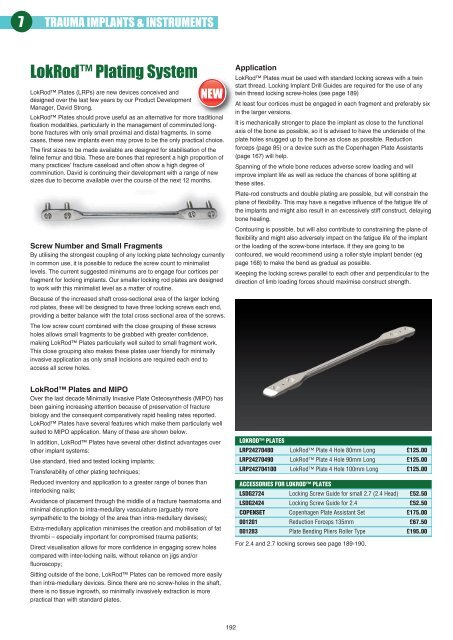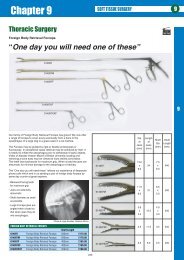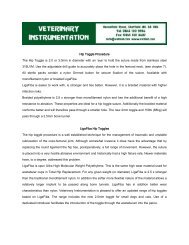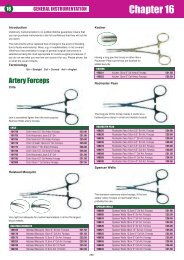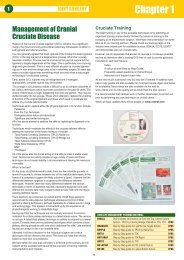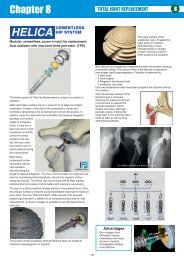Chapter 7 - Veterinary Instrumentation
Chapter 7 - Veterinary Instrumentation
Chapter 7 - Veterinary Instrumentation
Create successful ePaper yourself
Turn your PDF publications into a flip-book with our unique Google optimized e-Paper software.
7 TRAUMA IMPLANTS & INSTRUMENTSLokRod Plating SystemLokRod Plates (LRPs) are new devices conceived anddesigned over the last few years by our Product DevelopmentManager, David Strong.LokRod Plates should prove useful as an alternative for more traditionalfixation modalities, particularly in the management of comminuted longbonefractures with only small proximal and distal fragments. In somecases, these new implants even may prove to be the only practical choice.The first sizes to be made available are designed for stabilisation of thefeline femur and tibia. These are bones that represent a high proportion ofmany practices’ fracture caseload and often show a high degree ofcomminution. David is continuing their development with a range of newsizes due to become available over the course of the next 12 months.Screw Number and Small FragmentsBy utilising the strongest coupling of any locking plate technology currentlyin common use, it is possible to reduce the screw count to minimalistlevels. The current suggested minimums are to engage four cortices perfragment for locking implants. Our smaller locking rod plates are designedto work with this minimalist level as a matter of routine.Because of the increased shaft cross-sectional area of the larger lockingrod plates, these will be designed to have three locking screws each end,providing a better balance with the total cross sectional area of the screws.The low screw count combined with the close grouping of these screwsholes allows small fragments to be grabbed with greater confidence,making LokRod Plates particularly well suited to small fragment work.This close grouping also makes these plates user friendly for minimallyinvasive application as only small incisions are required each end toaccess all screw holes.ApplicationLokRod Plates must be used with standard locking screws with a twinstart thread. Locking Implant Drill Guides are required for the use of anytwin thread locking screw-holes (see page 189)At least four cortices must be engaged in each fragment and preferably sixin the larger versions.It is mechanically stronger to place the implant as close to the functionalaxis of the bone as possible, so it is advised to have the underside of theplate holes snugged up to the bone as close as possible. Reductionforceps (page 85) or a device such as the Copenhagen Plate Assistants(page 167) will help.Spanning of the whole bone reduces adverse screw loading and willimprove implant life as well as reduce the chances of bone splitting atthese sites.Plate-rod constructs and double plating are possible, but will constrain theplane of flexibility. This may have a negative influence of the fatigue life ofthe implants and might also result in an excessively stiff construct, delayingbone healing.Contouring is possible, but will also contribute to constraining the plane offlexibility and might also adversely impact on the fatigue life of the implantor the loading of the screw-bone interface. If they are going to becontoured, we would recommend using a roller style implant bender (egpage 168) to make the bend as gradual as possible.Keeping the locking screws parallel to each other and perpendicular to thedirection of limb loading forces should maximise construct strength.LokRod Plates and MIPOOver the last decade Minimally Invasive Plate Osteosynthesis (MIPO) hasbeen gaining increasing attention because of preservation of fracturebiology and the consequent comparatively rapid healing rates reported.LokRod Plates have several features which make them particularly wellsuited to MIPO application. Many of these are shown below.In addition, LokRod Plates have several other distinct advantages overother implant systems:Use standard, tried and tested locking implants;Transferability of other plating techniques;Reduced inventory and application to a greater range of bones thaninterlocking nails;Avoidance of placement through the middle of a fracture haematoma andminimal disruption to intra-medullary vasculature (arguably moresympathetic to the biology of the area than intra-medullary devises);Extra-medullary application minimises the creation and mobilisation of fatthrombi — especially important for compromised trauma patients;Direct visualisation allows for more confidence in engaging screw holescompared with inter-locking nails, without reliance on jigs and/orfluoroscopy;Sitting outside of the bone, LokRod Plates can be removed more easilythan intra-medullary devices. Since there are no screw-holes in the shaft,there is no tissue ingrowth, so minimally invasively extraction is morepractical than with standard plates.LOKROD PLATESLRP24270480 LokRod Plate 4 Hole 80mm Long £125.00LRP24270490 LokRod Plate 4 Hole 90mm Long £125.00LRP242704100 LokRod Plate 4 Hole 100mm Long £125.00ACCESSORIES FOR LOKROD PLATESLSDG2724 Locking Screw Guide for small 2.7 (2.4 Head) £52.50LSDG2424 Locking Screw Guide for 2.4 £52.50COPENSET Copenhagen Plate Assistant Set £175.00001201 Reduction Forceps 135mm £67.50001283 Plate Bending Pliers Roller Type £195.00For 2.4 and 2.7 locking screws see page 189-190.192


